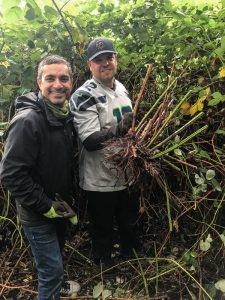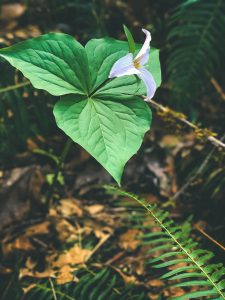It makes sense to care about weeds in your garden or on the farm, but what’s the harm of weeds in the forest? What even qualifies as a weed when it comes to our wild places?
In short, a weed is any plant that we don’t want in a particular place. Even a rose can be a weed if it’s growing in your strawberry field. When it comes to our wild places or even our semi-wild parks, what humans want can vary a lot. Maybe we want a forest or maybe we want a wetland. Maybe we want only Washington native plants or maybe we just want a healthy city park that’s going to give us the most diverse ecology for the space. Given all of the different wants, it can be hard to agree on which plants make the weed list. But however you slice it, an elite group of weeds known as “invasive weeds” stands above the rest

Invasive weeds are the conquerors of the weed world. The most famous in our part of the world is the ubiquitous (in the PNW) and delicious Himalayan blackberry, but there are plenty of others such as knotweed, scotch broom, and English ivy. The problem with these plants isn’t that they’re horrible nasty species; it’s that they just won’t stay put and they’re not good at sharing their spaces with other plants.
If you’re a tiny tree seedling, it’s going to be awfully hard to get your start in the dense shade of a stand of knotweed. Sure, blackberries are delicious, but how many can you actually eat? Can you even get to the ones in the middle of a bramble, dangling just out of reach? Even if you’re a bird that relies on berries for food, a blackberry bramble can be a food desert outside of the two months a year that they produce fruit.

Perhaps the biggest problem of all is that invasive weeds lead to a lack of diversity in an ecosystem. Some invasive weeds are just so successful at growing in the Pacific Northwest that the other plants, ones that have been evolving here for thousands upon thousands of years, don’t stand a chance against them. Given free reign, the wild forests rich with ferns and huckleberries might continue to turn into brambly hillsides, knotweed-covered stream banks, and reed canary grass-filled valleys.
If seeing invasive weeds all around you is making you feel overwhelmed, take heart. There is so much that you can do!
- Work on your own yard, making sure that none of your beloved landscaping is made up of invasive weeds. Keeping weeds out of yards also keeps them from spreading to the wild lands around us.
- Volunteer to remove weeds at local parks or even at Oxbow!
- Make invasive weed bouquets, just be sure to throw them away (don’t compost them) before they go to seed.
- Pick the blackberries. Every blackberry that goes into a pie, a smoothie, or straight into your mouth, is fifty fewer blackberry seeds in the world!
To learn more about invasive weeds, check out all of the great information offered by King County here and don’t forget to come out and pull some weeds here at Oxbow!
